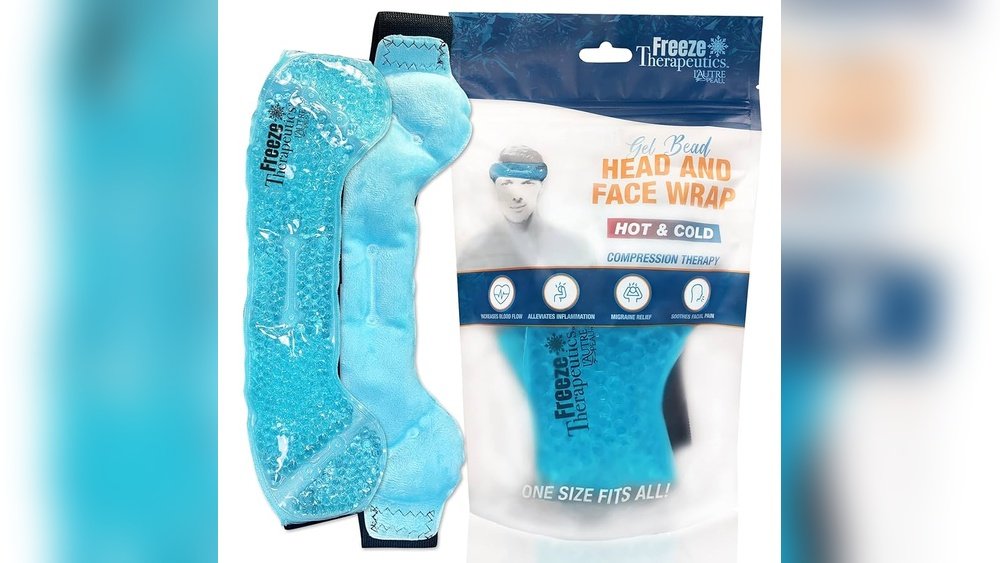When it comes to boosting your facial blood flow, choosing between a cold or warm compress can make a big difference— but which one is right for you? You might think cold always soothes and heat always relaxes, but the truth is more nuanced.
Your skin and muscles respond differently depending on whether you use cold or warm therapy, and knowing when to apply each can transform your skincare routine or recovery process. You’ll discover how cold compresses reduce inflammation by slowing blood flow, while warm compresses increase circulation and relax muscles.
Understanding these effects helps you decide exactly what your face needs, whether you’re tackling puffiness, tension, or soreness. Keep reading to learn which compress will give your face the care it deserves.

Credit: www.amazon.com
Effects Of Cold Compress
Cold compresses have a strong effect on facial blood flow and skin health. They help control swelling and reduce discomfort quickly. Using cold therapy on the face can calm irritated tissues and limit blood flow to the area. This creates a soothing sensation and speeds up recovery after injury or inflammation.
Understanding how cold compresses work can help you use them better. Below are key effects of cold compresses on blood vessels, swelling, and pain.
Blood Vessel Constriction
Cold causes blood vessels to narrow, a process called vasoconstriction. This reduces blood flow to the affected area. Less blood flow means less redness and heat in the skin. Narrowed vessels also slow down the movement of fluids into tissues, which helps prevent swelling. This effect is why cold compresses are useful right after injury or irritation.
Inflammation And Swelling Reduction
Inflammation happens when tissues swell due to injury or irritation. Cold therapy slows down the body’s inflammatory response. It limits fluid buildup and reduces puffiness. Using a cold compress on the face can quickly calm swollen areas. This helps skin look less puffy and feel more comfortable.
Pain Relief Mechanism
Cold compresses numb nerve endings in the skin. This lowers the sensation of pain in the treated area. The cold also slows down nerve signals that send pain messages to the brain. This makes cold therapy a simple and effective way to ease facial pain. Many people use cold compresses after dental work, insect bites, or minor burns to reduce discomfort.
Effects Of Warm Compress
Warm compresses have a significant impact on facial blood flow and tissue health. They gently raise the skin temperature, which helps improve circulation and relax muscles. This section explains how warm compresses benefit the face by increasing blood flow, easing muscle tension, and aiding in chronic pain management.
Increased Blood Flow
Applying warmth to the face causes blood vessels to widen. This expansion allows more blood to reach the area. Better circulation brings oxygen and nutrients to skin cells. It also helps remove waste and toxins from the tissues. Increased blood flow promotes faster healing and a healthier complexion.
Muscle Relaxation
Heat soothes tight facial muscles and reduces stiffness. Warm compresses help muscles relax by improving blood supply. Relaxed muscles mean less tension and discomfort. This can reduce headaches and facial pain caused by muscle strain. Warmth also prepares muscles for gentle stretching or massage.
Chronic Pain Management
Warm compresses are useful for managing long-term facial pain. Conditions like arthritis or nerve pain often respond well to heat therapy. The warmth decreases muscle spasms and eases joint stiffness. Regular use of warm compresses can improve comfort and mobility. It supports ongoing relief without the side effects of medication.
When To Use Cold Compress
Using a cold compress on the face can help control blood flow in specific situations. It works by narrowing blood vessels, which lowers swelling and numbs pain. Knowing when to use cold therapy improves healing and comfort. Below are key moments to choose cold compresses for facial care.
Acute Injuries
Cold compresses are best right after a fresh injury. They reduce swelling and prevent excess blood from pooling. For bruises, sprains, or bumps, apply cold to calm inflammation. This helps limit damage and speeds up recovery.
Post-workout Pain
After exercise, cold packs soothe sore muscles and reduce pain. They lower blood flow to tired areas, easing discomfort. Use cold on the face if you feel tightness or mild aches after physical activity.
Nerve Activity Reduction
Cold also slows nerve signals that send pain messages. This makes it useful for quick pain relief on the face. Applying a cold compress can calm nerves and reduce sharp or burning sensations.

Credit: chiroup.com
When To Use Warm Compress
Warm compresses boost blood flow by relaxing muscles and soft tissues. They help increase oxygen and nutrients to the skin and muscles. This makes warm compresses ideal for specific uses, especially when stiffness or chronic pain is present.
Knowing when to use a warm compress can improve comfort and healing. Below are key moments to apply gentle heat for the best results.
Muscle Stiffness Relief
Warm compresses soothe tight and stiff muscles. The heat helps muscles relax and eases discomfort. Use warm compresses after long periods of inactivity or sitting. They improve flexibility and reduce tension effectively.
Pre-exercise Preparation
Applying heat before exercise warms muscles and joints. This reduces the risk of injury during physical activity. Warm compresses increase blood flow to muscles, making them ready for movement. This helps improve performance and lowers muscle strain.
Chronic Conditions Support
Heat therapy supports people with chronic pain or arthritis. Warm compresses reduce deep muscle aches and joint stiffness. Use them regularly to manage ongoing discomfort. The heat improves circulation, which can help speed up recovery.
Combining Cold And Warm Compress
Combining cold and warm compresses can enhance facial blood flow better than using either alone. This method, known as contrast therapy, involves alternating between cold and warm applications. It helps stimulate circulation and supports healing. Using both temperatures wisely boosts skin health and reduces discomfort. Below are key points on benefits, timing, and safety.
Contrast Therapy Benefits
Contrast therapy improves blood circulation by making blood vessels tighten and relax. Cold compresses narrow vessels, lowering swelling and numbing pain. Warm compresses open vessels, increasing blood flow and relaxing muscles. This cycle reduces inflammation and speeds recovery. It can also improve skin tone and reduce puffiness. Many find it helpful after injuries or long days.
Application Timing
Start with a cold compress for about 5 to 10 minutes to reduce swelling. Then switch to a warm compress for 10 to 15 minutes to boost blood flow. Repeat this cycle two to three times. Avoid using heat right after a fresh injury. Use warm compresses before activities to loosen muscles. Cold compresses work best after exercise or injury.
Precautions And Safety Tips
Do not apply cold or warm compresses directly on the skin. Wrap them in a cloth to prevent burns or frostbite. Limit each application to 15 minutes to avoid skin damage. Stop if you feel pain or discomfort. People with sensitive skin or circulation problems should consult a doctor first. Avoid contrast therapy on open wounds or severe injuries.

Credit: arenaeyeworks.com
Frequently Asked Questions
Is A Hot Or Cold Compress Better For Blood Flow?
Heat compress improves blood flow by relaxing muscles and easing stiffness. Cold compress reduces blood flow by constricting vessels, lowering inflammation and swelling. Use heat for chronic pain and muscle stiffness; use cold for acute injuries. Alternating both can enhance circulation and healing.
What Is Better For Blood Flow, Hot Or Cold?
Heat improves blood flow by relaxing muscles and easing stiffness. Cold reduces blood flow by constricting vessels, helping with swelling and pain. Use heat for chronic issues and cold for acute injuries. Alternating heat and cold can enhance circulation and healing.
Is It Better To Ice Or Heat Your Face?
Use ice for acute injuries to reduce swelling and pain. Apply heat to relax muscles and improve blood flow in chronic stiffness or before exercise. Alternate both for enhanced circulation after initial injury swelling subsides.
What Is More Effective, A Hot Or Cold Compress?
Heat increases blood flow, easing muscle stiffness and chronic pain. Cold reduces blood flow, swelling, and numbs acute injuries. Use heat for muscle relaxation and cold for injury inflammation. Alternating both can enhance healing after swelling subsides. Choose based on your specific condition and needs.
What Effect Does A Cold Compress Have On Facial Blood Flow?
A cold compress narrows blood vessels, reducing blood flow and swelling in the treated area.
How Does A Warm Compress Improve Facial Blood Circulation?
Warm compresses widen blood vessels, increasing blood flow and relaxing muscles for pain relief.
Conclusion
Choosing between a cold or warm compress depends on your needs. Warm compresses boost blood flow and relax muscles. They help with stiffness and chronic pain. Cold compresses reduce blood flow, easing swelling and pain from injuries. Sometimes, alternating both can speed healing by improving circulation.
Always use compresses carefully and avoid long applications. If unsure, ask a healthcare professional for advice. Understanding these simple steps helps you care for your skin and muscles better.
 Skip to content
Skip to content 